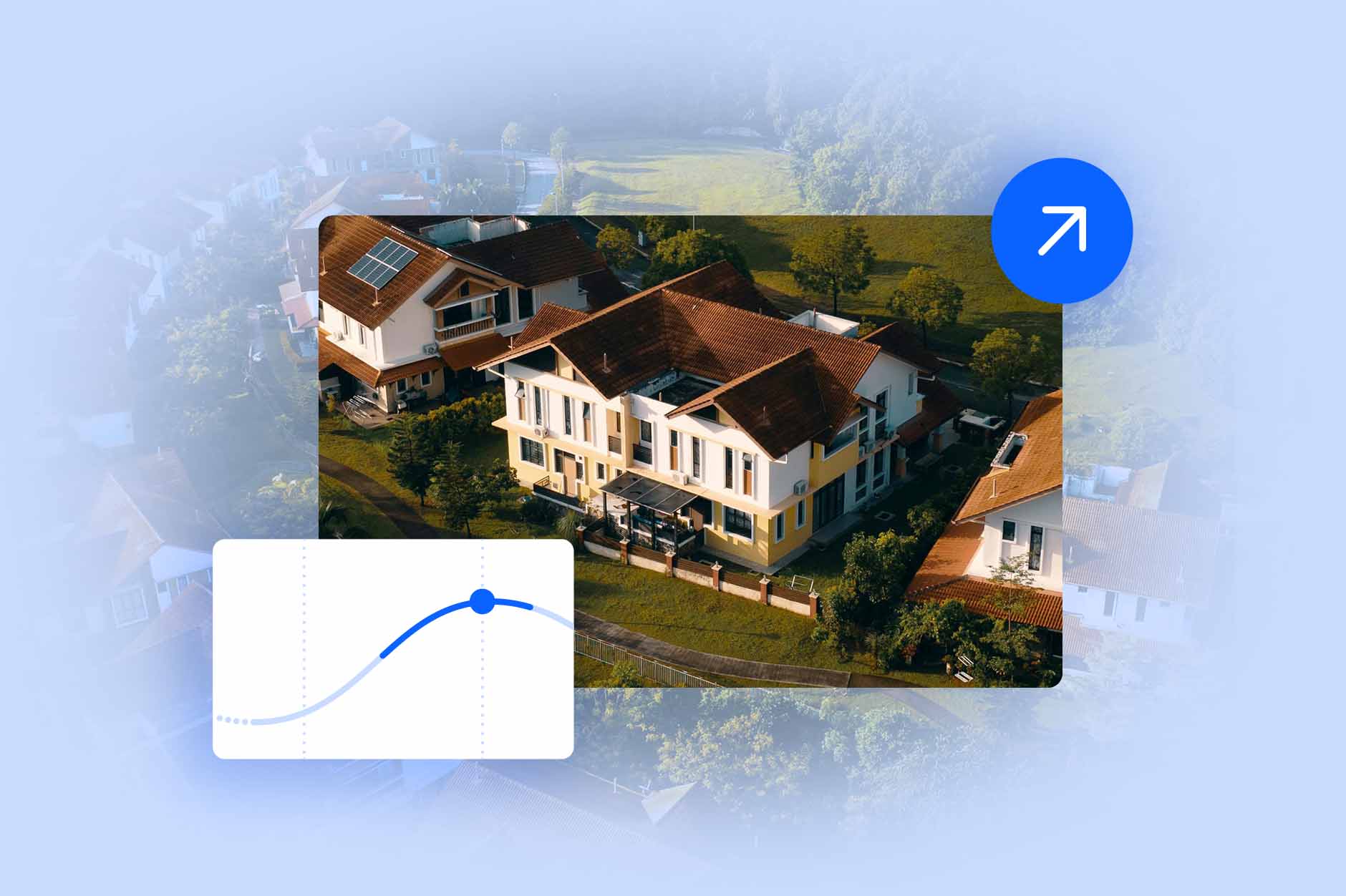
Now is a prime time for buyers in Florida, as the market shifts in their favor with increased inventory and negotiating power. Florida posted the second-highest number of closings nationwide in Q2 at 64,108, as shown in HouseCanary’s housing market forecast.
Sales volumes remain close to last year’s levels but are slipping quarter to quarter, signaling a market that’s cooling from its pandemic peak. For buyers, this means more options; for sellers, less pricing power; and for investors, a need to make more strategic buying decisions.
Let’s explore Florida’s 2025 housing trends, highlight key markets, and leverage HouseCanary’s regional data to help you navigate what’s ahead.
Key Takeaways
- Median Prices Decrease Slightly: Florida’s median closed price is $408,805 in Q3 2025, down slightly from last year.
- More Options for Buyers: Florida’s 127,109 listings and median of 74 days on market mean buyers have increased flexibility and leverage.
- Divergent Price Trends: Some metros continue to grow, like Tallahassee (+7.4%), while others, including Sebastian-Vero Beach (-4.6%), are declining.
Florida Housing Market Overview (Mid-2025)
The Florida housing market in mid-2025 shows a slight year-over-year decrease in median closed price, coupled with sustained inventory growth and an increase in median days on market.
Median Closed Price
According to HouseCanary data, the median closed price across Florida in Q3 2025 is $408,805. This represents a slight year-over-year decrease of -0.55% compared to Q3 2024 ($411,083). Quarter-over-quarter, the median closed price also saw a minor dip from $411,241 in Q2 2025. For buyers, this signals more negotiating power, as prices are stabilizing after years of rapid appreciation.
Number of Closings
HouseCanary volumes indicate that the number of closings in Q3 2025 reached 58,601, stable compared to Q3 2024 (58,593 closings). However, it represents a decrease of 11.7% from the 66,349 closings recorded in the previous quarter (Q2 2025). While total sales are still robust, the slower quarter-over-quarter pace means buyers have slightly more time and leverage in negotiations.
Inventory Growth
Florida's housing inventory has continued to grow. In Q3 2025, the inventory reached 127,109 units, marking a significant increase of 24.5% from 102,090 units in Q3 2024.
This growth trend is also evident quarter-over-quarter, with inventory increasing 13.2% from 113,017 in Q1 2025 to 127,979 in Q2 2025. This growing supply gives buyers more options and strengthens their position in a market that favors careful, strategic purchasing.
.png)
Median Days on Market:
The median days on market in Florida has seen a notable year-over-year increase.
In Q3 2025, properties are on the market for a median of 74 days, a substantial rise from 58 days in Q3 2024. This also represents an increase from 61 days in the prior quarter (Q2 2025), indicating more leverage for buyers.
Where Are Prices Falling (or Rising) in Florida?
Price trends vary significantly across different Florida submarkets year-over-year through Q3 2025, with some coastal and luxury areas experiencing declines. However, others, including some inland and specific coastal regions, continue to see growth.
Most Significant Price Drops
The following markets experienced the most significant listing price drops:
- Sebastian-Vero Beach-West Vero Corridor, FL (-4.61%)
- Homosassa Springs, FL (-4.36%)
- Ocala, FL (-3.04%)
- Lakeland-Winter Haven, FL (-2.06%)
- Miami-Fort Lauderdale-West Palm Beach, FL (-1.97%)
Markets with Stable Price Performance
Several markets demonstrated relatively stable price performance, with year-over-year listing price changes between -1% and 1%:
- Jacksonville, FL (0.20%)
- Naples-Marco Island, FL (+0.49%)
- Orlando-Kissimmee-Sanford, FL (+0.03%)
- Palm Bay-Melbourne-Titusville, FL (-0.71%)
- Panama City-Panama City Beach, FL (-0.86%)
Cities with Continued Price Growth
Some markets continue to experience listing price growth:
- Gainesville, FL (+1.31%)
- Pensacola-Ferry Pass-Brent, FL (+2.10%)
- North Port-Bradenton-Sarasota, FL (+3.40%)
- Tallahassee, FL (+7.40%)
.png)
What’s Fueling the Shift in Florida’s Housing Market?
High mortgage rates and years of price growth have pushed many Florida buyers out of reach, with rising insurance premiums and HOA fees adding further strain. At the same time, the migration surge that once fueled demand has slowed.
The rental market is also showing signs of strain. Inventory of single-family rentals has nearly doubled since Q3 2023, forcing investors to make concessions and cut rents to retain tenants. A softer rental market often means more buyers staying on the sidelines, so flippers may need to be more selective about which properties they renovate.
“Single-family rental prices will continue to decline slightly over the next year. We expect rental prices to decline another 2-2.5% over the next four quarters, mirroring price declines over the past four quarters.”
—Chris Stroud, HouseCanary Chief of Research
Together, these dynamics highlight a market in transition. One where buyers gain leverage, sellers must recalibrate, and investors need to focus carefully on metro-level trends to find the best investment markets.
What’s Next for Florida’s Housing Market?
Let’s take a look at housing market predictions to better understand where the market is headed.
Near-Term Forecast
HouseCanary’s proprietary data regarding Housing Price Index (HPI) shows that home prices in the near term are expected to remain fairly stable. From Q3 2025 to Q4 2025, the HPI is projected to decline slightly by 0.73%.
This small drop suggests that, while prices aren’t rising quickly, the market isn’t seeing a steep slowdown either. Current demand, driven by buyers looking for affordable options and continued interest from investors, helps keep the market steady, preventing larger declines.
For a deeper dive into neighborhood-level trends, Property Explorer provides detailed analytics and interactive data to help you track market activity locally.
12-Month to 3-Year Forecast
- 12-month: Based on the current HouseCanary HPI forecast showing small quarterly percentage changes (averaging 0.31% YoY), the base case for the next 12 months suggests stability with slight fluctuations. Prices are not expected to see dramatic shifts, and inventory will continue to influence market dynamics.
- 3-year: Extending this through Q2 2028, assuming current housing market trends persist, the market is likely to remain relatively balanced (1.13% change YoY).
This suggests that while prices may not see significant gains, they are also unlikely to experience sharp declines. The combination of steady demand and ample inventory is expected to keep the market conditions fairly consistent over the next few years.
“Consistent with these HPI percentage changes, Florida is expected to remain in a buyer's market due to months supply staying above 6 months. Healthy sales volume will be offset by elevated and increasing inventory. Consequently, price growth, as indicated by the flat to slightly increasing HPI percentage changes, will likely remain flat to slightly down, and days on market will remain elevated — both hallmarks of a buyer's market.”
—Chris Stroud, HouseCanary Chief of Research
Stay Ahead of Florida’s Housing Trends with Localized Data
Florida’s housing market shows a mix of trends: some metros are seeing steady activity, while others are experiencing moderate slowdowns. Median prices remain largely stable, near-term forecasts suggest only slight changes, and months of supply are keeping many areas in a buyer’s market. Understanding these local patterns can help you make informed decisions and plan effectively.
That's where HouseCanary’s tools provide an advantage. With Property Explorer now available on mobile, you can access comps, AVMs, and market data anywhere, turning every property visit into an informed decision point.
Equipped with CanaryAI’s advanced capabilities, such as image-based valuations, instant ARV estimates, and ZIP-level queries, you can make faster and smarter decisions.
Get started with HouseCanary today to stay ahead in the Florida housing market.
FAQ About Florida’s Housing Market
Is It a Good Time to Buy a Home in Florida Now?
As of Q3 2025, with rising inventory and longer days on market, buyers have more options and negotiating power, making it a favorable time to purchase in many metros.
Will Florida Home Prices Rebound in 2026?
Prices are expected to stabilize, with modest growth in some areas, but significant statewide rebounds are unlikely in the near term. Strong buyer demand driven by Florida’s year-round climate, job growth, and lifestyle appeal helps support steady activity in many metros, even as the market remains relatively balanced.
Is Florida in a Housing Crisis/Will the Florida Housing Market Crash?
Florida is not in a housing crisis, and a market crash is unlikely. As of Q3 2025, high prices and regional imbalances create challenges for some buyers and renters, including limited affordable options in high-demand metros, increased competition, and longer commutes for more reasonably priced homes.














.jpeg)








